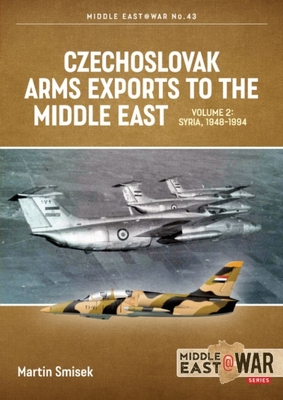Czechoslovak Arms Exports to the Middle East: Volume 2 - Egypt, 1948-1990

Czechoslovak Arms Exports to the Middle East: Volume 2 - Egypt, 1948-1990
During the Cold War, communist Czechoslovakia was one of the largest arms exporters to the Middle East among the Soviet Bloc countries. The second volume of this mini-series describes the history of arms exports from Czechoslovakia to Egypt including related military assistance.
Although Egypt had expressed interest in buying Czechoslovak arms just before the 1948 Arab-Israeli War, no deliveries were eventually made. The reason was the preferences of Prague, which fully supported Israel. The situation began to change from July 1950 when Czechoslovakia banned exports of its weapons to the Jewish country. These developments culminated in September 1955, when the first huge Czechoslovak-Egyptian arms deal was concluded. As a proxy of Moscow, Prague delivered impressive quantities of armament and ammunition together with spare parts, logistics, and support equipment.
At the same time, Czechoslovak military instructors and advisors were sent to Egypt. A crucial role was played by a group of Czechoslovak Air Force personnel, whose task was to provide the tactical and combat training for two Egyptian fighter squadrons equipped with MiG-15bis jets prior to the Suez Crisis in 1956. At the same time, Egyptian military specialists were trained in the facilities of the Czechoslovak People's Army. However, from the end of the 1950s, there was a significant reduction in the supply of military hardware from Czechoslovakia because Prague was unwilling or unable to supply the state-of-the-art weapons required by the Egyptians.
Therefore, the focus of Czechoslovak-Egyptian military cooperation in the following years was limited to the establishment of the Military Technical College in Cairo and different military repair facilities around Egypt. The situation in the supply of Czechoslovak armament to Egypt began to change gradually in the mid-1960s as the Czechoslovak arms industry commenced the production of a new generation of weapons developed by domestic industry or provided under Soviet license. A huge boom in arms deals occurred after the Egyptian defeat in the 1967 Arab-Israeli War. During the following years, Czechoslovakia supplied Egypt with OT-62 armored personnel carriers, T-55 tanks, MiG-21F-13 fighters and L-29 Delfin jet trainers, which subsequently took part in the fighting of the 1973 Arab-Israeli War. Another major turning point came in the mid-1970s with the deterioration of Soviet-Egyptian relations. Following instructions from Mo
PRP: 143.64 Lei
Acesta este Prețul Recomandat de Producător. Prețul de vânzare al produsului este afișat mai jos.
129.28Lei
129.28Lei
143.64 LeiLivrare in 2-4 saptamani
Descrierea produsului
During the Cold War, communist Czechoslovakia was one of the largest arms exporters to the Middle East among the Soviet Bloc countries. The second volume of this mini-series describes the history of arms exports from Czechoslovakia to Egypt including related military assistance.
Although Egypt had expressed interest in buying Czechoslovak arms just before the 1948 Arab-Israeli War, no deliveries were eventually made. The reason was the preferences of Prague, which fully supported Israel. The situation began to change from July 1950 when Czechoslovakia banned exports of its weapons to the Jewish country. These developments culminated in September 1955, when the first huge Czechoslovak-Egyptian arms deal was concluded. As a proxy of Moscow, Prague delivered impressive quantities of armament and ammunition together with spare parts, logistics, and support equipment.
At the same time, Czechoslovak military instructors and advisors were sent to Egypt. A crucial role was played by a group of Czechoslovak Air Force personnel, whose task was to provide the tactical and combat training for two Egyptian fighter squadrons equipped with MiG-15bis jets prior to the Suez Crisis in 1956. At the same time, Egyptian military specialists were trained in the facilities of the Czechoslovak People's Army. However, from the end of the 1950s, there was a significant reduction in the supply of military hardware from Czechoslovakia because Prague was unwilling or unable to supply the state-of-the-art weapons required by the Egyptians.
Therefore, the focus of Czechoslovak-Egyptian military cooperation in the following years was limited to the establishment of the Military Technical College in Cairo and different military repair facilities around Egypt. The situation in the supply of Czechoslovak armament to Egypt began to change gradually in the mid-1960s as the Czechoslovak arms industry commenced the production of a new generation of weapons developed by domestic industry or provided under Soviet license. A huge boom in arms deals occurred after the Egyptian defeat in the 1967 Arab-Israeli War. During the following years, Czechoslovakia supplied Egypt with OT-62 armored personnel carriers, T-55 tanks, MiG-21F-13 fighters and L-29 Delfin jet trainers, which subsequently took part in the fighting of the 1973 Arab-Israeli War. Another major turning point came in the mid-1970s with the deterioration of Soviet-Egyptian relations. Following instructions from Mo
Detaliile produsului










